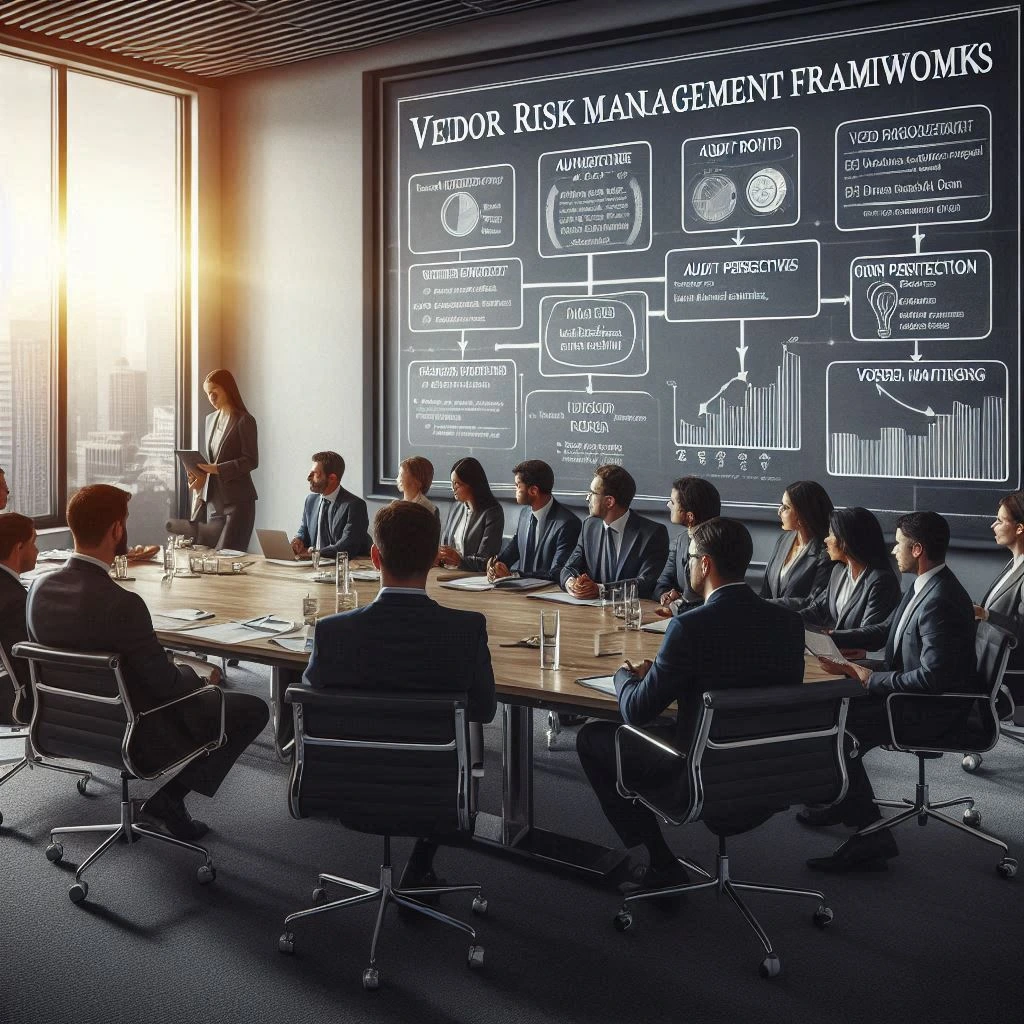In today’s interconnected business landscape, organizations increasingly rely on third-party vendors to enhance operational efficiency, reduce costs, and access specialized expertise. This reliance, however, brings with it a host of risks that necessitate a robust vendor audit process and vendor risk management framework, particularly from an internal audit perspective.
Defining Vendor Risk Management
Vendor risk management (VRM) refers to the systematic process of identifying, assessing, and mitigating risks associated with third-party vendors. This process is crucial for internal audit functions as it ensures that organizations maintain compliance with regulatory requirements, safeguard sensitive data, and uphold their reputations. Internal auditors play a pivotal role in evaluating vendor relationships, ensuring that appropriate due diligence is conducted, and that ongoing monitoring is in place to address any emerging risks [4][8].
The Growing Dependence on Third-Party Vendors
The trend of outsourcing services to third-party vendors has become prevalent across various industries, including finance, healthcare, and technology. Organizations are increasingly leveraging external expertise to drive innovation and efficiency. However, this growing dependence also amplifies the complexity of managing vendor relationships and the associated risks. As businesses integrate more third-party services into their operations, the need for a structured approach to vendor risk management becomes paramount.
Potential Risks Associated with Vendors
Engaging with third-party vendors introduces several potential risks that organizations must address:
- Compliance Risks: Vendors may not adhere to regulatory standards, leading to potential legal repercussions for the organization. Internal audits can help ensure that vendors comply with relevant laws and regulations [15].
- Operational Risks: Disruptions in vendor services can impact an organization’s operations. This includes risks related to service delivery failures, data breaches, or inadequate performance, which can hinder business continuity [10].
- Reputational Risks: The actions of a vendor can directly affect an organization’s reputation. If a vendor experiences a data breach or fails to meet service expectations, the organization may suffer reputational damage, impacting customer trust and loyalty [4].
Establishing a comprehensive vendor risk management framework is essential for organizations to navigate the complexities of third-party relationships. Internal auditors are integral to this process, ensuring that risks are identified, assessed, and mitigated effectively, thereby safeguarding the organization’s operational integrity and reputation.
Understanding the Vendor Audit Process
In the realm of internal auditing, the vendor audit process is a critical component of a robust vendor risk management framework. This process not only ensures compliance with regulatory standards but also safeguards the organization against potential risks associated with third-party vendors. Below, we outline the essential steps involved in the vendor audit process, emphasizing its objectives and the pivotal role of internal auditors.
Defining the Vendor Audit Process and Its Objectives
The vendor audit process is a systematic approach to evaluating third-party suppliers to ensure they meet the organization’s standards for security, compliance, and operational effectiveness. The primary objectives of this process include:
- Risk Assessment: Identifying and assessing the risks associated with vendor relationships, including operational, financial, and compliance risks.
- Compliance Verification: Ensuring that vendors adhere to relevant regulations and internal policies.
- Performance Evaluation: Assessing the vendor’s performance against established criteria and service level agreements (SLAs) to ensure they deliver value to the organization.
Key Phases of the Vendor Audit Process
The vendor audit process can be broken down into four key phases:
- Planning: This initial phase involves defining the audit’s objectives and scope. Internal auditors must identify the specific areas to be evaluated, such as financial stability, compliance with regulations, and operational capabilities. Effective planning also includes gathering relevant documentation and preparing audit checklists to guide the process [1][2].
- Fieldwork: During this phase, auditors conduct the actual audit activities. This includes reviewing vendor documentation, analyzing transactions, and conducting interviews with vendor representatives. The goal is to gather sufficient evidence to assess the vendor’s compliance and performance against the established criteria [14].
- Reporting: After completing the fieldwork, auditors compile their findings into a comprehensive report. This report should outline the audit results, highlight any identified risks or compliance issues, and provide actionable recommendations for improvement. Clear communication of findings is essential to ensure that stakeholders understand the implications of the audit results [2][3].
- Follow-Up: The final phase involves monitoring the implementation of the recommendations provided in the audit report. Internal auditors should establish a follow-up process to ensure that the vendor addresses any identified issues and that corrective actions are taken. This phase is crucial for maintaining ongoing vendor compliance and performance [1][3].
The Role of Internal Auditors in Conducting Vendor Audits
Internal auditors play a vital role in the vendor audit process. Their responsibilities include:
- Independence and Objectivity: Internal auditors provide an unbiased assessment of vendor performance and compliance, which is essential for maintaining the integrity of the audit process [12].
- Expertise in Risk Management: With their knowledge of risk management principles, internal auditors can effectively identify potential vulnerabilities within vendor relationships and recommend appropriate mitigation strategies [15].
- Continuous Improvement: By conducting regular vendor audits, internal auditors help organizations continuously improve their vendor risk management framework, ensuring that it adapts to changing regulatory requirements and market conditions.
The vendor audit process is a structured approach that enables organizations to manage vendor risks effectively. By understanding the key phases and the role of internal auditors, risk managers can enhance their vendor risk management frameworks and ensure that their organizations remain compliant and secure in their vendor relationships.
Establishing a Structured Vendor Risk Management Framework
Creating a robust Vendor Risk Management (VRM) framework is essential for organizations to effectively manage the risks associated with third-party vendors. This section outlines the key components of a VRM framework, how to align it with organizational risk appetite and compliance requirements, and best practices for implementation.
Components of a Vendor Risk Management Framework
Risk Assessment:
- Definition: This involves identifying and evaluating the potential risks that vendors may pose to the organization. It includes assessing the vendor’s financial stability, operational capabilities, and compliance with relevant regulations.
- Best Practices: Utilize standardized risk assessment tools to ensure consistency. Categorize vendors based on risk levels to prioritize assessments and resources effectively.
Due Diligence:
- Definition: This process involves conducting thorough background checks and evaluations of potential vendors before engagement. It ensures that vendors meet the organization’s standards for quality and compliance.
- Best Practices: Implement a checklist for due diligence that includes financial audits, compliance checks, and references from other clients. Regularly update due diligence processes to reflect changes in regulations or industry standards.
Monitoring:
- Definition: Continuous monitoring of vendor performance and compliance is crucial to identify any emerging risks throughout the vendor relationship.
- Best Practices: Establish key performance indicators (KPIs) to measure vendor performance against agreed-upon standards. Schedule regular reviews and audits of vendor activities to ensure compliance with contractual obligations and regulatory requirements.
Reporting:
- Definition: Effective reporting mechanisms are necessary to communicate vendor risk status to stakeholders and facilitate informed decision-making.
- Best Practices:
Develop a standardized reporting format that includes risk metrics, compliance status, and any incidents or breaches. Ensure that reports are accessible to relevant stakeholders, including risk managers and internal auditors, to promote transparency and accountability.
Aligning the Framework with Organizational Risk Appetite and Compliance Requirements
To ensure that the VRM framework is effective, it must align with the organization’s overall risk appetite and compliance obligations. This involves:
- Understanding Risk Appetite: Organizations should define their risk tolerance levels, which will guide the risk assessment and management processes. This alignment helps in making informed decisions about vendor selection and risk mitigation strategies.
- Compliance Integration: The framework should incorporate relevant regulatory requirements and industry standards. This ensures that the organization not only mitigates risks but also remains compliant with laws and regulations, thereby avoiding potential penalties and reputational damage.
Establishing a structured vendor risk management framework is vital for organizations to navigate the complexities of third-party relationships. By focusing on the key components of risk assessment, due diligence, monitoring, and reporting, and aligning these processes with organizational risk appetite and compliance requirements, risk managers and internal auditors can create a comprehensive approach to managing vendor risks effectively. Implementing best practices in each component will further enhance the framework’s effectiveness, ensuring that organizations are well-prepared to handle the challenges posed by their vendor networks.
Conducting Vendor Risk Assessments
In the realm of internal audit and risk management, conducting thorough vendor risk assessments is essential for establishing a robust Vendor Risk Management (VRM) framework. This section outlines the criteria for assessing vendor risks, discusses effective tools and methodologies, and emphasizes the importance of categorizing vendors based on their risk levels.
Criteria for Assessing Vendor Risks
When evaluating vendors, it is crucial to consider several key criteria that can significantly impact your organization’s risk profile:
- Financial Stability: Assessing a vendor’s financial health is vital. This includes reviewing financial statements, credit ratings, and any history of bankruptcy or financial distress. A financially unstable vendor may pose a higher risk of service disruption or failure, which can affect your operations [3][12].
- Security Controls: Evaluate the vendor’s security measures to ensure they align with your organization’s standards. This involves examining their data handling practices, incident response capabilities, and overall security policies. A thorough assessment verifies that the vendor’s stated security measures are effective and meet your requirements [10].
- Compliance History: Understanding a vendor’s compliance with relevant regulations and standards is essential. This includes reviewing their history of compliance with data protection laws, industry standards, and any past incidents of non-compliance. A vendor with a poor compliance record may introduce significant legal and reputational risks [14].
Tools and Methodologies for Effective Vendor Risk Assessments
To conduct effective vendor risk assessments, organizations can utilize various tools and methodologies:
- Risk Assessment Frameworks: Implementing a structured risk assessment framework can streamline the evaluation process. Frameworks such as NIST, ISO 27001, or specific VRM frameworks provide guidelines for assessing vendor risks systematically [2][6].
- Checklists and Templates: Utilizing checklists can help ensure that all critical areas are covered during the assessment. These checklists can include questions related to financial stability, security controls, and compliance history, making the assessment process more efficient [8][14].
- Automated Tools: Leveraging technology through automated risk assessment tools can enhance the efficiency and accuracy of the assessment process. These tools can help in gathering data, analyzing risks, and generating reports, allowing auditors to focus on higher-level analysis and decision-making [11][12].
Importance of Categorizing Vendors Based on Risk Levels
Categorizing vendors based on their risk levels is a crucial step in the vendor risk assessment process. This classification allows organizations to:
- Prioritize Resources: By identifying high-risk vendors, organizations can allocate resources more effectively, focusing on those that pose the greatest threat to their operations [14].
- Tailor Risk Management Strategies: Different risk levels require different management strategies. High-risk vendors may need more frequent assessments and closer monitoring, while lower-risk vendors might require less intensive oversight [6][12].
- Enhance Decision-Making: A clear understanding of vendor risk levels aids in making informed decisions regarding vendor selection, contract negotiations, and ongoing vendor management [13].
Conducting thorough vendor risk assessments is a foundational element of a successful Vendor Risk Management framework. By establishing clear criteria for assessment, utilizing effective tools and methodologies, and categorizing vendors based on risk levels, risk managers and internal auditors can significantly enhance their organization’s resilience against vendor-related risks.
Integrating Continuous Monitoring into Vendor Audits
In the realm of vendor risk management, continuous monitoring plays a pivotal role in ensuring that vendor relationships remain compliant and effective over time. This section delves into the significance of continuous monitoring within the vendor audit process, highlighting its definition, the technologies that support it, and real-world examples that illustrate its benefits.
Defining Continuous Monitoring
Continuous monitoring refers to the ongoing assessment of vendor performance and compliance with established standards and contractual obligations. This proactive approach allows organizations to identify potential risks and issues before they escalate, thereby fostering stronger vendor relationships and enhancing overall risk management. By integrating continuous monitoring into the vendor audit process, organizations can ensure that vendors consistently meet performance metrics and compliance requirements, which is essential for maintaining service quality and regulatory adherence [2][7].
Technologies and Tools for Ongoing Monitoring
To facilitate effective continuous monitoring, organizations can leverage various technologies and tools designed to track vendor performance and compliance in real-time. Some of the key technologies include:
- Performance Management Software: These tools help establish key performance indicators (KPIs) and automate the tracking of vendor performance against these metrics. This allows for timely identification of any deviations from expected performance levels [2].
- Compliance Management Systems: These systems enable organizations to monitor vendor compliance with regulatory requirements and internal policies. They often include features for documentation, reporting, and alerts for non-compliance.
- Data Analytics Tools: By utilizing data analytics, organizations can analyze vendor performance data to identify trends, anomalies, and potential risks. This data-driven approach enhances decision-making and supports more informed vendor management strategies [10].
- Automated Risk Assessment Tools: These tools can continuously assess vendor risk profiles based on various factors, including financial stability, operational capabilities, and compliance history. This ongoing assessment helps organizations stay ahead of potential risks associated with their vendors.
Integrating continuous monitoring into the vendor audit process is essential for effective vendor risk management. By defining continuous monitoring, utilizing appropriate technologies, and learning from real-world case studies, risk managers and internal auditors can enhance their vendor management frameworks, ensuring compliance and performance standards are consistently met. This structured approach not only mitigates risks but also contributes to the overall success of vendor relationships.
Reporting and Communicating Audit Findings
In the realm of vendor risk management, the audit process plays a crucial role in identifying potential risks and ensuring compliance. However, the effectiveness of an audit is significantly influenced by how findings are reported and communicated. Here are key considerations for structuring audit reports and effectively conveying results to stakeholders.
Structuring Audit Reports for Clarity and Impact
Clear Objectives and Scope: Begin the report by outlining the audit’s objectives and scope. This sets the context for the findings and helps stakeholders understand the focus of the audit. Clearly defined objectives ensure that the report remains relevant and targeted, allowing readers to grasp the purpose of the audit quickly [2].
Comprehensive Findings: Present findings in a structured manner, categorizing them by risk level or compliance issues. This organization aids in clarity and allows stakeholders to prioritize areas that require immediate attention. Including specific examples and data can enhance the impact of the findings, making them more relatable and actionable [3].
Recommendations for Improvement: Each finding should be accompanied by actionable recommendations. This not only provides a pathway for addressing identified issues but also demonstrates the audit’s value in enhancing vendor management practices. Recommendations should be realistic and tailored to the organization’s capabilities and resources [11].
Importance of Communicating Risks and Recommendations
Effective communication of audit findings is essential for fostering a culture of risk awareness within the organization.
- Engaging Stakeholders: It is vital to communicate risks and recommendations to all relevant stakeholders, including senior management and the board. This ensures that decision-makers are informed and can take appropriate actions to mitigate risks. Highlighting the potential impact of identified risks on the organization can help in garnering the necessary attention and resources for remediation [3][15].
- Utilizing Visual Aids: Incorporating visual aids such as charts, graphs, and dashboards can enhance understanding and retention of information. Visual representations of data can make complex findings more accessible and engaging, facilitating better discussions during presentations.
Tips for Presenting Findings to Senior Management and the Board
Tailor the Presentation: Understand the audience’s perspective and tailor the presentation accordingly. Senior management and board members often focus on strategic implications, so emphasize how the audit findings align with organizational goals and risk appetite [4].
Be Concise and Direct: Time is often limited for senior leaders, so present findings concisely. Use bullet points to summarize key issues and recommendations, allowing for quick comprehension. Avoid jargon and technical language that may obscure the message [5].
Encourage Dialogue: Foster an environment for open discussion during the presentation. Encourage questions and feedback, which can lead to a deeper understanding of the findings and promote collaborative problem-solving. This engagement can also help in building trust and credibility with stakeholders.
The reporting and communication of audit findings are critical components of the vendor audit process. By structuring reports for clarity, effectively communicating risks, and presenting findings in a tailored manner, internal auditors can significantly enhance the impact of their audits and contribute to a robust vendor risk management framework.
Challenges and Considerations in Vendor Audits
Vendor audits are essential for ensuring compliance, quality, and reliability within supply chains. However, they come with a unique set of challenges that can hinder the audit process. Understanding these challenges and implementing effective strategies can significantly enhance the vendor audit experience for risk managers and internal auditors.
Common Challenges Faced During Vendor Audits
Data Access: One of the primary obstacles in vendor audits is obtaining accurate and reliable data. Many organizations struggle with data management, which can lead to incomplete or inaccurate information being available for the audit process [8]. This lack of access can impede the auditors’ ability to conduct thorough evaluations.
Vendor Cooperation: Gaining the cooperation of vendors can be challenging. Vendors may be reluctant to share sensitive information or may not fully understand the audit process, leading to delays and potential conflicts [10]. This lack of engagement can result in incomplete assessments and missed opportunities for improvement.
Resource Limitations: Internal audit teams often face constraints in terms of time and personnel. As audit teams are tasked with analyzing more data and identifying risks associated with new growth opportunities, insufficient resources can hinder their effectiveness [12]. This challenge is compounded by a talent shortage in the auditing field, making it difficult to attract and retain qualified staff [9].
Strategies for Overcoming These Challenges
Building Strong Vendor Relationships: Establishing and maintaining strong relationships with vendors is crucial. Open communication and collaboration can foster a more cooperative environment, making it easier to obtain necessary data and insights. Regular engagement with vendors can help them understand the importance of the audit process and their role in it [10].
Implementing a Structured Approach: Developing a structured vendor risk management framework can streamline the audit process. This includes clearly defining audit objectives, expectations, and timelines, which can help set the stage for a more organized and efficient audit [14].
Continuous Professional Development: Internal auditors should invest in ongoing training and development to enhance their skills and knowledge. This can help them navigate complex vendor relationships and improve their ability to conduct effective audits [6].
The Role of Technology in Addressing Audit Challenges
Technology plays a pivotal role in overcoming many of the challenges associated with vendor audits. By leveraging advanced data analytics tools, auditors can gain better insights into vendor performance and compliance. These tools can facilitate:
- Improved Data Management: Technology can streamline data collection and analysis, ensuring that auditors have access to accurate and timely information [8].
- Enhanced Communication: Digital platforms can facilitate better communication between auditors and vendors, making it easier to share information and address concerns promptly [10].
- Resource Optimization: Automation of routine audit tasks can free up valuable time for auditors, allowing them to focus on more strategic aspects of the audit process [12].
While vendor audits present several challenges, a structured approach combined with strong vendor relationships and the effective use of technology can significantly enhance the audit process. By addressing these challenges proactively, risk managers and internal auditors can ensure a more efficient and effective vendor risk management framework.
Conclusion: Building a Resilient Vendor Risk Management Function
In today’s complex business environment, the significance of a structured approach to vendor risk management cannot be overstated. A well-defined vendor audit process is essential for organizations to ensure that their suppliers meet compliance obligations and adhere to quality standards. This structured approach not only mitigates risks associated with third-party vendors but also enhances overall operational efficiency and supplier performance. By implementing a comprehensive vendor audit framework, organizations can proactively identify potential risks and address them before they escalate into significant issues.
To foster a culture of continuous improvement, it is crucial for risk managers and internal auditors to adopt the best practices outlined throughout this blog. These practices include:
- Setting Clear Audit Objectives: Clearly defining the purpose and scope of each audit helps ensure that all relevant areas are assessed effectively [1].
- Utilizing a Comprehensive Vendor Audit Checklist: A detailed checklist ensures a systematic and thorough audit process, covering all necessary aspects of vendor performance and compliance.
- Planning and Preparation: Adequate preparation is key to a smooth audit process, allowing auditors to gather valuable insights and streamline their efforts [2][3].
- Reviewing and Improving the Audit Process: After each audit, it is essential to evaluate the process to identify areas for improvement, thereby enhancing future audits [4].
By embracing these best practices, organizations can build a resilient vendor risk management function that not only safeguards against potential risks but also strengthens vendor relationships.
As a call to action, we encourage risk managers and internal auditors to seek further resources or training opportunities to enhance their vendor audit skills. Engaging in professional development can provide valuable insights into emerging trends and methodologies in vendor risk management. Consider exploring workshops, webinars, or certification programs focused on vendor audits and risk management to stay ahead in this critical area. By investing in knowledge and skills, organizations can ensure that their vendor risk management frameworks remain robust and effective in the face of evolving challenges.
Find out more about Shaun Stoltz https://www.shaunstoltz.com/about/
This post was written by an AI and reviewed/edited by a human.



